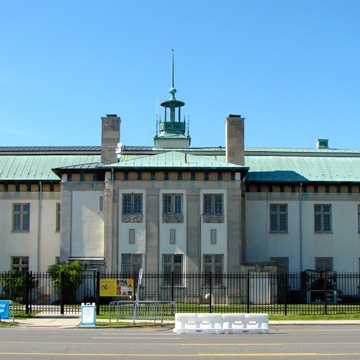With the demolition of the old Municipal Stadium (later John F. Kennedy Stadium, 1925–1926, Simon and Simon), the Swedish Historical Museum is the principal surviving structure of the Sesquicentennial Exhibition. Unlike the 1876 fair that highlighted the achievements of modern industry, the 1926 fair focused on Philadelphia's eighteenth-century history with a re-creation of old High (Market) Street, and little that was new. The John Hanson–John Morton Memorial Building was named for Hanson, the first president of the United States under the Articles of Confederation, and Morton, a Pennsylvania member of the Continental Congress and signer of the Declaration. It followed in the same vein, here mixing elements of Swedish seventeenth-century architecture with references to George Washington's Mount Vernon. This historical stew was mixed up by a University of Pennsylvania professor, Amandus Johnson, whose specialty was Swedish—that is to say ancestor—history. The building, based on Eriksberg's Slott, a seventeenth-century mansion in Sweden, was intended to convey the sophistication of Swedish design to contrast with the rustic primitiveness of their local buildings. The museum was enlarged and restored in 2003.
You are here
American Swedish Historical Museum
1926, John Nyden; 2003 restored and additions, Campbell Thomas and Company. 1900 Pattison Ave., Franklin Delano Roosevelt Park
If SAH Archipedia has been useful to you, please consider supporting it.
SAH Archipedia tells the story of the United States through its buildings, landscapes, and cities. This freely available resource empowers the public with authoritative knowledge that deepens their understanding and appreciation of the built environment. But the Society of Architectural Historians, which created SAH Archipedia with University of Virginia Press, needs your support to maintain the high-caliber research, writing, photography, cartography, editing, design, and programming that make SAH Archipedia a trusted online resource available to all who value the history of place, heritage tourism, and learning.















